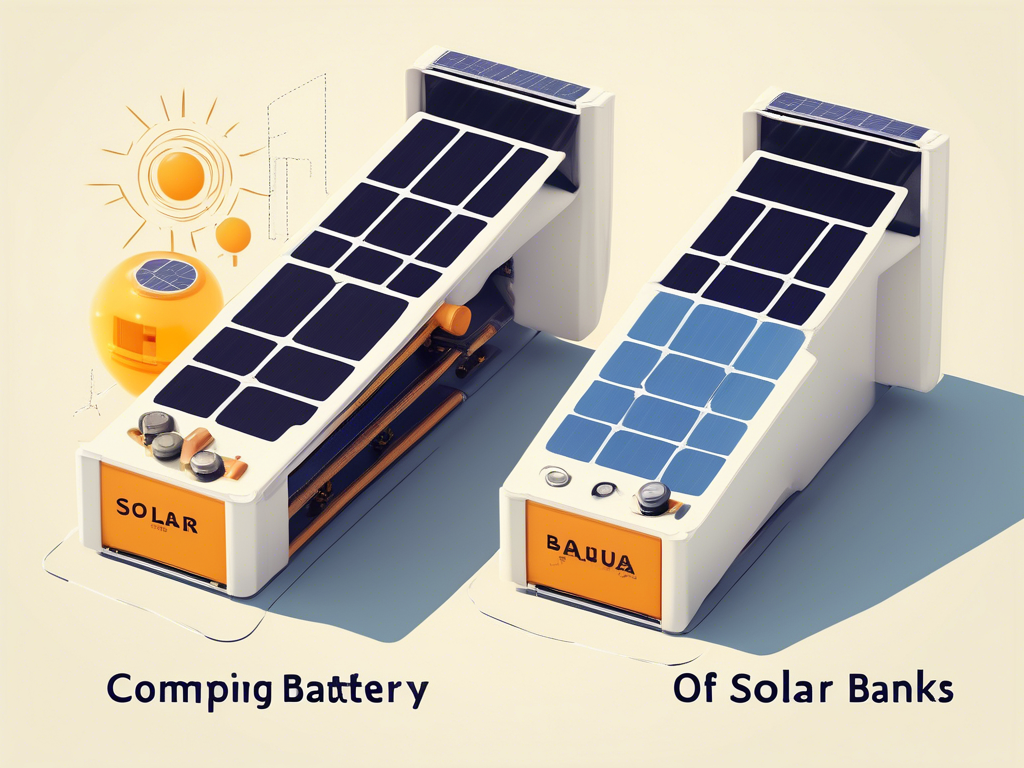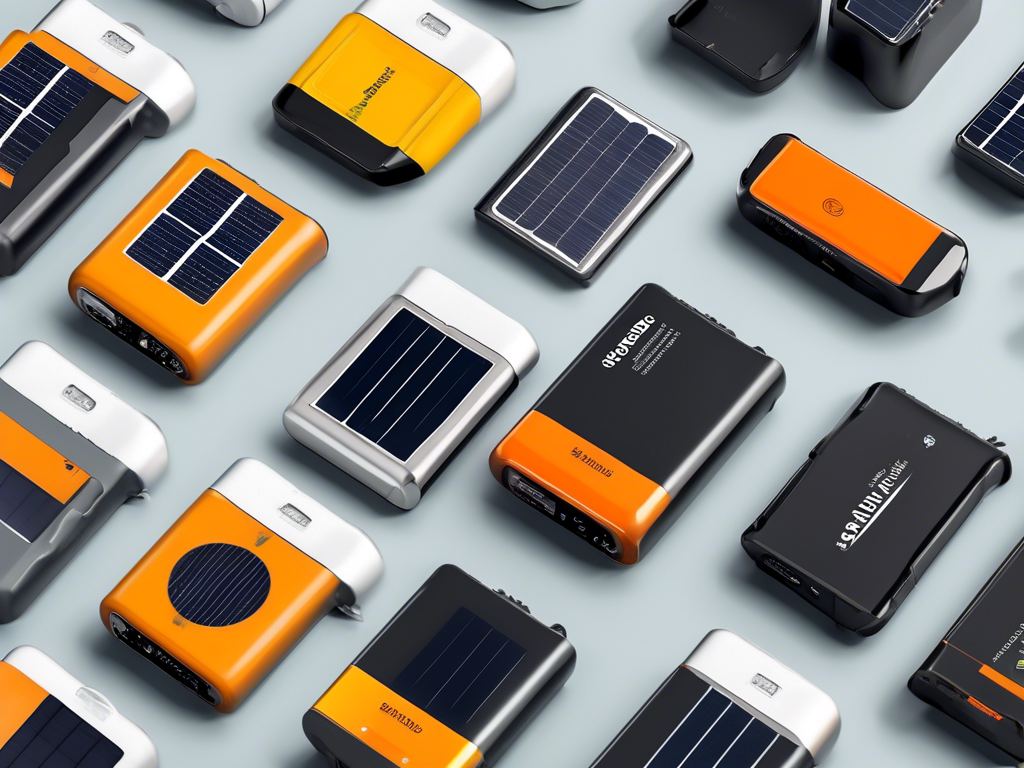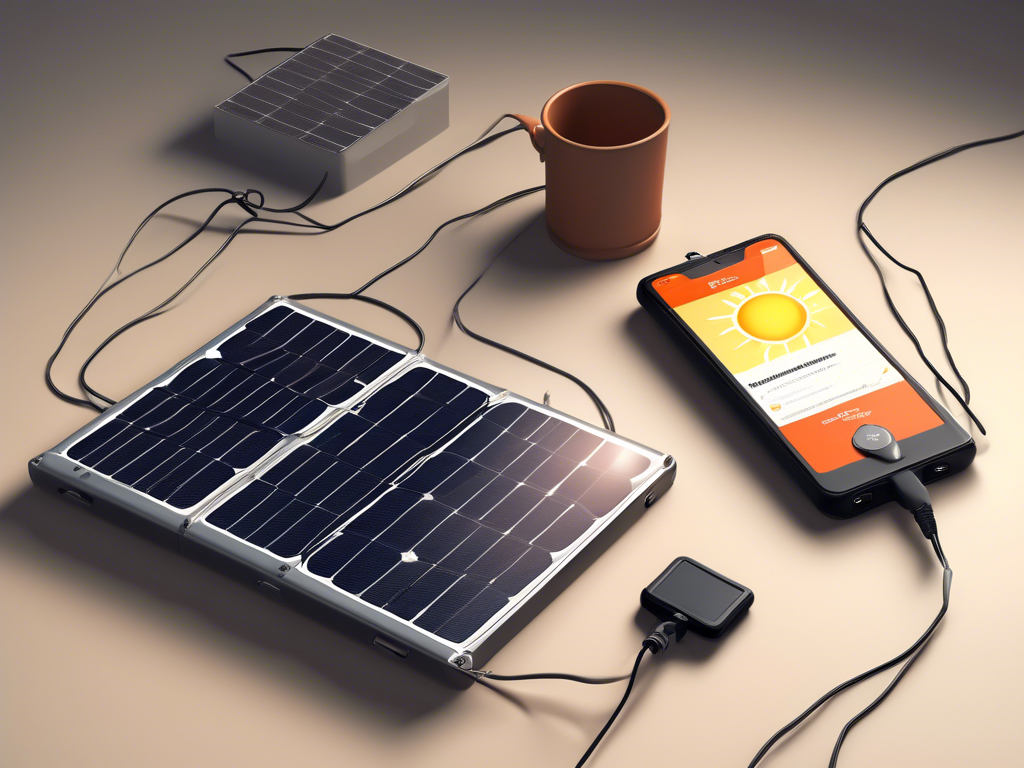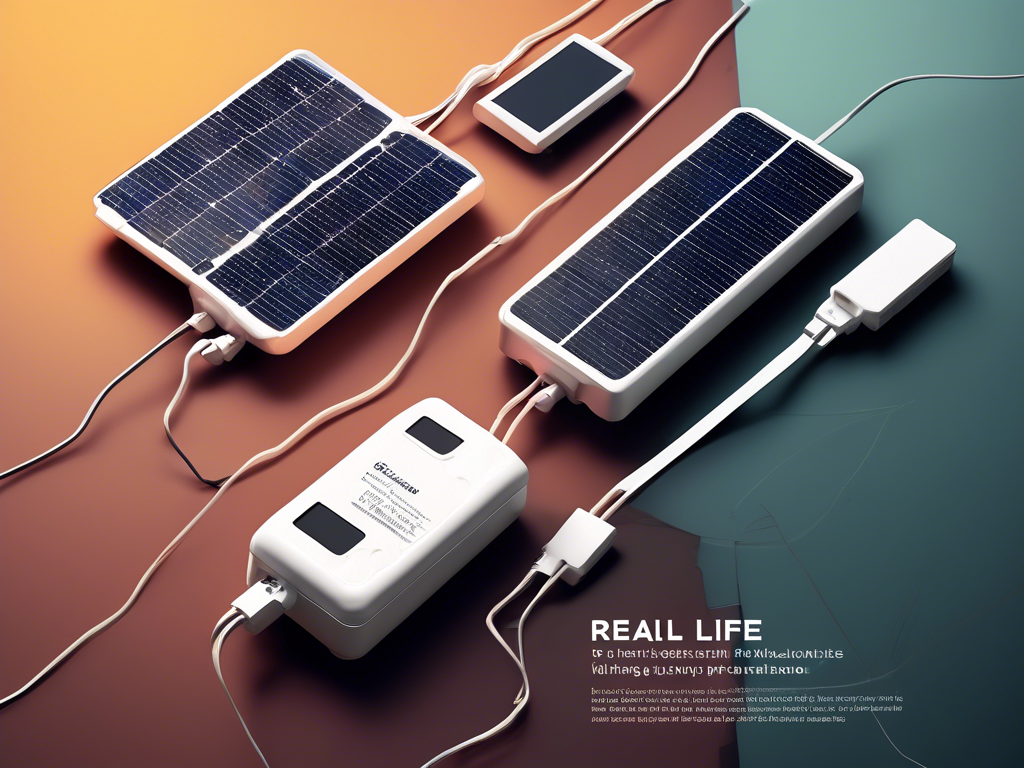As the world increasingly turns towards sustainable energy solutions, solar battery bank chargers have emerged as vital components in harnessing renewable power. Imagine harnessing the sun’s energy to keep your devices charged and ready for action, no matter where you are! This article delves deep into the mechanics of solar charging and the variety of options available to you.
Understanding how solar battery chargers function is crucial for both enthusiasts and casual users. The innovation behind these devices not only reduces our dependency on conventional electricity sources but also offers a pathway toward a more eco-friendly lifestyle. From boating adventures to camping trips, having the right power solution can make all the difference.
Throughout this comprehensive guide, we will explore important topics including the science behind solar power, essential features to consider when selecting a charger, and how to maximize efficiency in utilizing solar energy. We will also compare various types of solar battery banks and highlight top brands and models to help you make an informed decision. Lastly, we will touch upon common pitfalls to avoid, real-life applications, and future trends shaping this dynamic industry. By the end of this article, you’ll have a clear understanding of what to look for in a solar battery charger power bank and be well-equipped to choose the best option for your needs.
Understanding the Basics of Solar Battery Bank Chargers

What is a Solar Battery Bank Charger?
A solar battery bank charger is a device that harnesses solar energy to charge batteries, allowing you to store power for later use. These chargers act as a bridge between the solar panels and your batteries, ensuring efficient energy transfer. By converting sunlight into electricity, they play a crucial role in off-grid living and renewable energy solutions. 🌞
How Do Solar Battery Bank Chargers Work?
The operation of a solar battery charger power bank involves several key components: solar panels, a charge controller, and the battery bank itself. Here’s a simplified breakdown:
1. **Solar Panels**: Capture sunlight and convert it into direct current (DC) electricity.
2. **Charge Controller**: Regulates the voltage and current coming from the solar panels to ensure batteries are charged safely and efficiently.
3. **Battery Bank**: Stores the generated electricity for later use.
By managing the flow of electricity, these components work together to maximize your solar energy system’s efficiency. ⚡️
Benefits of Using Solar Battery Bank Chargers
Opting for a solar battery charger power bank comes with several advantages, including:
– **Energy Independence**: Reduce reliance on the grid and harness free solar energy.
– **Cost Savings**: Lower electricity bills by utilizing stored solar power.
– **Sustainability**: Make a positive impact on the environment by using renewable resources.
– **Backup Power**: Ensure you have electricity during outages or emergencies.
These benefits make solar battery bank chargers an attractive option for both residential and commercial applications. 🌍
Factors to Consider When Choosing a Solar Battery Bank Charger
When selecting a solar battery bank charger, keep the following factors in mind:
– **Capacity**: Ensure the charger can handle the total capacity of your battery bank.
– **Efficiency**: Look for chargers with high conversion efficiencies to maximize your solar input.
– **Compatibility**: Your charger should be compatible with the type of batteries you are using.
– **Durability**: Choose a robust design especially suited for outdoor conditions.
Making an informed choice is essential for optimizing the performance of your solar energy system. 🔋
Conclusion: The Importance of Solar Battery Bank Chargers
In summary, understanding how solar battery bank chargers work is fundamental for anyone considering solar energy solutions. These devices not only enhance your energy independence but also promote sustainability. By choosing the right charger for your needs, you can ensure that your solar setup runs smoothly and effectively. 🌱
The Science Behind Solar Power: How Charging Works

How Solar Energy is Captured
The process of charging with solar energy begins with the solar panels, which are designed to capture sunlight and convert it into electricity. When sunlight hits the photovoltaic cells in the panels, it excites electrons, generating direct current (DC) electricity. This is the foundation of how a solar battery charger power bank operates, as it transforms the sun’s rays into usable electrical energy. 🌞
The Role of Charge Controllers
After the solar panels generate electricity, the next step involves the charge controller. This component plays a vital role in managing the flow of electricity from the solar panels to the battery bank. It ensures that the batteries are charged at the correct voltage and prevents overcharging, which can damage the batteries. Key functions of the charge controller include:
– **Voltage Regulation**: Maintains optimal charging levels.
– **Current Limiting**: Prevents excess current from entering the batteries.
– **Battery Monitoring**: Displays information on battery status and health.
Effective control over these aspects is crucial for a successful solar charging setup. ⚡️
Batteries: Storing Solar Energy
The final piece of the puzzle is the battery bank. This is where the electricity generated by solar panels is stored for later use. Different types of batteries can be used in solar applications, including lead-acid and lithium-ion. Each has its own pros and cons regarding lifespan, capacity, and charge cycles. Considerations when selecting batteries include:
– **Capacity**: How much energy can be stored?
– **Discharge Rate**: How quickly can energy be released?
– **Lifespan**: How long will the battery last before needing replacement?
Understanding these factors will help you choose the right battery bank for your solar battery charger power bank system. 🔋
Efficiency of Solar Charging Systems
The efficiency of a solar battery bank charger greatly impacts how much usable energy you can derive from your solar setup. Several factors influence this efficiency, including:
– **Quality of Solar Panels**: Higher quality panels often provide better energy conversion rates.
– **Ambient Temperature**: Excessive heat can reduce panel efficiency.
– **Angle of Installation**: Proper installation angle maximizes sun exposure throughout the day.
By optimizing these factors, users can significantly enhance the performance of their solar energy systems. 🌍
The Future of Solar Charging Technology
As technology continues to evolve, so does the potential of solar battery chargers. Innovations in materials and design are leading to improved efficiencies and lower costs. Some exciting upcoming trends include:
– **Bifacial Solar Panels**: These panels capture sunlight from both sides, increasing energy generation.
– **Smart Charge Controllers**: Advanced controllers that use algorithms to optimize charging based on weather and usage patterns.
– **Integrated Battery Solutions**: Combining solar panels, batteries, and charge controllers into a single unit for streamlined installation.
Staying informed about these advancements can help you make more educated choices when investing in solar battery charging solutions. 🌱
Key Features to Look for in a Solar Battery Charger

Charging Capacity
When selecting a solar battery charger power bank, one of the most critical features to consider is the charging capacity. This refers to how much energy the charger can provide to your batteries within a given time frame. A higher capacity allows you to fully recharge larger battery banks, making it essential for off-grid applications or extended use. Always assess your energy requirements and choose a charger that can meet or exceed them. 🔋
Efficiency Ratings
Another crucial aspect of a solar battery charger is its efficiency rating, which indicates how well it converts solar energy into usable electrical power. Look for chargers with high efficiency ratings—typically above 90%—to ensure minimal energy loss during the conversion process. The more efficient the charger, the quicker your batteries will be charged, which is particularly advantageous when sunlight is limited. ⚡️
Durability and Weather Resistance
Since solar chargers are often used outdoors, their durability and weather resistance should not be overlooked. Select a solar battery charger designed to withstand various environmental conditions, including rain, humidity, and extreme temperatures. Look for features such as rugged casing, waterproof designs, and corrosion-resistant materials to ensure longevity and reliable performance. 🌧️
Port Compatibility
To maximize the usability of your solar battery charger power bank, consider the compatibility of its ports. Ensure that the charger has multiple output options such as USB, DC, and AC ports to accommodate different devices and battery types. Flexibility in port availability allows for simultaneous charging of multiple devices, enhancing convenience during outdoor adventures or emergencies. 🔌
Smart Technology Features
Modern solar battery chargers come equipped with smart technology features that enhance performance and user experience. Look for chargers with built-in monitoring systems that provide real-time data on battery status, charging levels, and energy consumption. Some advanced models even offer Wi-Fi connectivity for remote monitoring through apps. These features add a layer of convenience and help you manage energy usage more effectively. 📱
Brand Reputation and Warranty
Finally, consider the brand reputation and warranty options available with your chosen solar battery charger. Established brands often offer better customer support and quality assurance. A solid warranty signifies the manufacturer’s confidence in their product, providing peace of mind regarding your investment. Always read reviews and do your research before making a decision to ensure you select a reliable charger. 🏆
Comparing Different Types of Solar Battery Banks

Lead-Acid vs. Lithium-Ion Batteries
When choosing a solar battery bank charger, one of the primary decisions revolves around battery type. The two most common options are lead-acid and lithium-ion batteries. Each has its advantages:
– **Lead-Acid Batteries**: Generally more affordable and widely available. They are robust and can handle deep discharges, making them suitable for various applications. However, they are heavier and have a shorter lifespan (around 5-7 years).
– **Lithium-Ion Batteries**: These batteries are lightweight, compact, and have a longer lifespan (up to 15 years). They offer greater depth of discharge and higher efficiency but come at a higher price point. Their advanced technology often allows for faster charging times. ⚡️
Understanding these differences will help you determine which type aligns best with your energy needs and budget.
Portable vs. Stationary Solar Battery Banks
Another key distinction in solar battery bank chargers is whether they are portable or stationary.
– **Portable Solar Battery Banks**: Ideal for camping trips or outdoor activities, these compact units allow users to charge devices on the go. They typically feature USB ports for easy device charging and have built-in solar panels for convenient recharging. 🌐
– **Stationary Solar Battery Banks**: Designed for home or business use, these systems usually connect to an existing solar panel setup. They provide higher capacity and can store significant amounts of energy to power entire homes or larger appliances. Consider how you plan to use your battery bank before making a choice.
Off-Grid vs. Grid-Tied Systems
The functionality of your solar battery charger power bank will also depend on whether you choose an off-grid or grid-tied system.
– **Off-Grid Systems**: These setups function independently from the utility grid. They rely solely on solar energy and stored battery power, making them perfect for remote locations. With a suitable solar battery bank charger, users can ensure a continuous power supply. 🌳
– **Grid-Tied Systems**: These systems remain connected to the utility grid, allowing you to draw electricity when your energy production is low. They often include net metering features, enabling users to sell excess power back to the grid. This option is ideal for those looking to reduce their electricity bills while maintaining grid access.
Battery Management Systems
A crucial element of any solar battery charger power bank is the battery management system (BMS). This component monitors the status of the battery bank, ensuring optimal performance and longevity.
Key functions of a BMS include:
– **State of Charge Monitoring**: Keeps track of the battery’s charge level.
– **Temperature Control**: Prevents overheating by managing thermal conditions.
– **Balancing**: Ensures all cells within the battery pack charge evenly, prolonging overall battery life. 🔋
When considering a solar battery bank, look for systems that include a reliable BMS to enhance efficiency.
Cost Considerations and ROI
Finally, evaluating the cost-effectiveness of your solar battery charger choice is essential. While initial investments may vary significantly between battery types and systems, it’s important to consider the return on investment (ROI) over time.
– **Upfront Costs**: Some systems, like lithium-ion setups, boast higher upfront costs but lower lifetime operational expenses due to longevity and efficiency.
– **Savings**: Calculate potential energy savings and how quickly you’ll recoup your initial investment based on your usage patterns and local electricity rates.
Taking time to analyze these factors can lead to a well-informed decision, ensuring your solar battery bank charger meets both your immediate and long-term needs. 💰
Top Brands and Models of Solar Battery Charger Power Banks

Renogy Solar Battery Chargers
Renogy is a leading name in the world of solar energy solutions, known for its high-quality solar battery charger power bank products. Their chargers are designed with versatility in mind, making them suitable for various applications—from camping trips to home backup systems. Notable models include the Renogy 20W and 50W solar panels, which effectively convert sunlight into energy and feature intelligent charge controllers that ensure optimal battery health. Users appreciate their robust build and user-friendly designs, making them a favorite among outdoor enthusiasts. 🌄
Anker PowerPort Solar Lite
Anker is widely recognized for its innovative tech products, and the Anker PowerPort Solar Lite is no exception. This solar battery charger offers portability and efficiency, with dual USB ports that allow you to charge multiple devices simultaneously. Its lightweight design and durable fabric make it perfect for hiking or travel. The built-in SmartIC technology optimizes charging speed, ensuring your devices get the most power possible from the sun. 📱
A solar battery charger power bank from ALLPOWERS
ALLPOWERS provides a range of powerful solar battery charger options, including models with integrated batteries for easy storage. Their 18V 12W charger is ideal for RVs and outdoor gear, making it an excellent choice for adventurers. The combination of high conversion efficiency and compact design ensures that you can harness solar energy effectively, even in the most remote areas. With features like overcharge and short-circuit protection, ALLPOWERS chargers promise reliability and safety. 🌞
How to Maximize Efficiency with Your Solar Charger

Optimize Your Solar Panel Placement
The positioning of your solar battery charger power bank is crucial for maximizing its efficiency. Ensure that your solar panels are placed where they can receive direct sunlight for the longest periods throughout the day. Consider the following tips for optimal placement:
– **Angle**: Adjust the angle of your panels according to the season to capture maximum sunlight.
– **Location**: Avoid shaded areas, such as trees or buildings, that can block sunlight.
– **Height**: Elevate the panels to reduce the risk of dirt and debris buildup that can obstruct solar absorption. 🌞
Monitor Energy Consumption
To make the most of your solar battery charger, keep an eye on your energy usage. Understanding how much power your devices consume will help you better manage your charging cycles. You can do this by:
– **Using Energy Meters**: These devices help you track your daily energy consumption.
– **Prioritizing Devices**: Charge essential devices first and save less critical ones for when energy availability allows.
– **Setting Charging Times**: Use timers to charge devices during peak sunlight hours for increased efficiency. ⚡️
Regular Maintenance and Cleaning
Maintaining your solar equipment can significantly impact its efficiency. Regular cleaning ensures that the solar panels remain free of dust and debris that could hinder performance. Follow these maintenance tips:
– **Wipe Down Panels**: Use a mild detergent and water to clean the surface of the panels.
– **Check Connections**: Inspect and tighten any loose wiring or connections in your solar battery charger system.
– **Inspect for Damage**: Regularly check for cracks or wear that could decrease efficiency and replace damaged parts promptly. 🧼
Utilize Smart Charging Technology
Investing in a solar battery charger power bank equipped with smart charging technology can enhance efficiency by optimizing charging cycles. Features to look for include:
– **Automatic Voltage Regulation**: This ensures that your batteries are charged at the correct voltage, preventing overcharging.
– **Battery Management Systems (BMS)**: These systems monitor battery health and charge status to prolong battery life and improve performance.
– **Remote Monitoring Apps**: Many modern chargers come with mobile apps that allow you to monitor solar generation and battery status, enabling better decision-making. 📱
Consider Battery Size and Type
The capacity and type of battery used in your solar battery bank charger play a significant role in overall efficiency. Consider the following aspects when choosing batteries:
– **Capacity Matching**: Ensure that your solar charger’s capacity aligns with your energy needs to avoid underperformance.
– **Battery Type**: Lithium-ion batteries typically offer higher efficiency and longer life compared to lead-acid batteries.
– **Depth of Discharge (DoD)**: Choose batteries with a higher DoD percentage to maximize usable energy storage. 🔋
Plan for Seasonal Variations
Seasonal changes can affect solar energy generation. To ensure consistent efficiency throughout the year, consider these strategies:
– **Adjust System Design**: Be prepared to alter your setup for winter months when sunlight might be scarcer.
– **Increase Storage Capacity**: Investing in a larger solar battery charger power bank during high-production summer months can help compensate for lower production in winter.
– **Track Sunlight Availability**: Use solar energy tracking apps to know when and where you can expect the most sunlight throughout different seasons. 🌍
Common Mistakes to Avoid When Choosing a Solar Battery Bank

Overlooking Capacity Needs
One of the most common mistakes people make when selecting a solar battery bank charger is underestimating their capacity needs. It’s essential to calculate the total energy consumption of your devices and choose a charger that can handle it. Failing to do so may result in insufficient power storage, leading to frustration during peak usage times. 📊
1. **Assess Your Usage**: Determine how much energy you typically consume.
2. **Calculate Total Capacity**: Ensure the charger supports your energy needs by matching its capacity with your consumption levels.
3. **Consider Future Growth**: Plan for potential increases in energy demand by selecting a charger with extra capacity.
Ignoring Compatibility Issues
Another mistake is neglecting compatibility between the solar battery charger power bank and your existing solar panel system or battery type. Not all chargers work with every battery or panel configuration.
– **Check Specifications**: Always verify the input/output specifications of your charger against your solar panels and batteries.
– **Factor in Voltage Requirements**: Ensure that voltages match across your devices to avoid damaging components.
Ignoring these details can lead to costly repairs or replacements down the line. 🔄
Choosing Based Solely on Price
Selecting a solar battery charger based purely on price is a frequent oversight. While budget is important, sacrificing quality for a lower price can affect performance and longevity.
– **Research Brand Reputation**: Look for trusted brands with positive reviews and proven track records.
– **Consider Warranty Options**: A good warranty can often indicate the manufacturer’s confidence in their product.
– **Evaluate Features**: Compare features and technology advancements, as a slightly higher investment may yield better efficiency and savings over time. 💸
Neglecting Maintenance and Care
Many users ignore the necessary maintenance required to keep their solar battery bank chargers functioning optimally. Regular upkeep is crucial for longevity and performance.
– **Routine Cleaning**: Dust and debris can accumulate on panels, reducing efficiency. Clean them regularly.
– **Check Wiring**: Inspect connections for wear or corrosion that could compromise functionality.
– **Monitor Performance**: Keep an eye on charging rates and storage levels to identify any issues early. 🛠️
Disregarding Environmental Factors
Finally, failing to consider environmental conditions can lead to poor performance of your solar battery charger power bank. Issues such as shading, temperature extremes, and orientation can significantly impact efficiency.
– **Monitor Sunlight Exposure**: Make sure your panels are positioned to receive maximum sunlight throughout the day.
– **Account for Climate**: Be aware of how seasonal changes can affect your energy generation; adjust systems accordingly.
– **Protect Equipment**: Choose weather-resistant materials for your charger to enhance durability under various environmental conditions. 🌦️
By avoiding these common mistakes, you can ensure a more effective and enjoyable experience with your solar battery bank charger.
Real-Life Applications: Where Solar Battery Chargers Shine

Outdoor Adventures and Camping
One of the most popular real-life applications for a solar battery charger power bank is during outdoor activities like camping or hiking. These chargers provide an excellent solution for powering essential devices such as smartphones, GPS units, and portable lights without relying on traditional electricity sources. 🌲
Consider bringing a solar battery charger if you’re planning an extended stay in nature. They are lightweight and portable, often coming with built-in USB ports that allow multiple devices to charge concurrently. This guarantee of connectivity ensures you can share your adventures or find your way home even in the wild!
Emergency Preparedness
In times of crisis, a reliable source of power can be a lifesaver. Solar battery chargers act as a dependable backup power option during outages caused by storms or other emergencies. By charging your devices in advance, you can ensure that communication lines remain open, and you have access to critical information during a power failure. ⚠️
Here’s how you can effectively integrate solar battery chargers into your emergency plans:
– **Charge Beforehand**: Always keep a charged solar battery bank ready at home.
– **Portable Options**: Opt for models that can easily be transported to different locations if needed.
– **Multiple Outputs**: Choose chargers with various output options to accommodate different devices.
Traveling Off the Grid
For those looking to travel off the grid, a solar battery charger power bank becomes essential. Whether you’re traveling by RV, van, or merely backpacking, these chargers allow you to maintain a level of comfort and connectivity that manual options cannot offer. 🚌
Travelers can use solar chargers to power:
– **Laptops for Work**: Stay productive while on the move.
– **Cameras for Capturing Memories**: Ensure your equipment has power for those unforgettable moments.
– **Portable Coolers**: Keep food and drinks cool during long trips.
Unlock the freedom of off-grid living by utilizing solar energy for all your electronic needs!
Home Energy Independence
Homeowners looking to become more energy-independent can significantly benefit from installing a solar battery charger as part of their residential solar setup. These systems provide a method to store excess energy generated during sunny days for use when natural sunlight isn’t available, especially during peak hours in the evening. 🏡
Benefits include:
– **Reduced Electricity Bills**: Decrease reliance on the grid and cut costs.
– **Sustainability**: Contribute to environmental efforts by utilizing renewable energy.
– **Increased Resilience**: Enjoy a reliable source of power even during utility outages.
Investing in solar battery chargers not only serves financial interests but also supports a sustainable lifestyle.
Electric Vehicle Charging
As electric vehicles (EVs) gain popularity, incorporating a solar battery charger power bank into your charging strategy can enhance the sustainability of your vehicle usage. With the right setup, you can use solar energy to charge your EV, minimizing dependence on grid electricity and lowering overall carbon emissions. 🚗
To maximize efficiency:
– **Home Integration**: Combine your home solar panel system with a solar battery charger to create a coherent energy ecosystem.
– **Off-the-Grid Charging**: Utilize portable solar chargers during road trips, allowing for EV charges whenever sunlight is available.
Implementing these technologies will help create a more environmentally friendly transportation system.
Future Trends in Solar Battery Technology and Their Impact

Advancements in Energy Storage Solutions
Emerging technologies in solar battery chargers are focused on improving energy storage efficiency. Innovations like solid-state batteries promise higher energy densities and safety compared to traditional lithium-ion options. These developments mean that future solar battery charger power banks could store more energy in smaller, lighter packages, enabling users to power devices for extended periods without needing frequent recharges. 🌟
Integration with Smart Home Systems
The integration of solar battery bank chargers with smart home technology is another trend on the rise. Future models will likely feature connectivity options, allowing homeowners to monitor and manage their energy consumption through mobile apps. This will enhance the efficiency of solar energy systems by optimizing when energy is stored or used based on real-time analysis of weather patterns and energy demands. 📲
Enhanced Recycling and Sustainability Practices
Sustainability in the manufacturing and disposal of solar battery chargers is becoming increasingly important. As consumer awareness grows, brands are adopting greener practices like recycling old batteries and using sustainable materials in production. By supporting these initiatives, consumers can contribute to a circular economy that reduces waste and promotes renewable energy solutions. ♻️
Emergence of Bifacial Solar Panels
One exciting development in solar technology is the advent of bifacial solar panels. These panels capture sunlight from both sides, increasing energy production dramatically. When combined with an efficient solar battery charger power bank, users can significantly boost their energy generation and storage capabilities. This shift towards dual-sided solar panels could redefine the landscape of solar energy, making it even more accessible and efficient. ☀️
Portable Charging Solutions for Everyday Use
As the demand for portable energy solutions grows, we can expect innovations in solar battery charger power banks designed for everyday use. Future products may include foldable solar panels that integrate seamlessly into tech gadgets, providing a continuous power supply for smartphones and laptops. This convenience opens up new possibilities for travelers, outdoor enthusiasts, and anyone seeking greater energy independence. 🌍
Government Incentives and Policy Support
As governments worldwide push for cleaner energy solutions, there will be an increase in incentives and policies supporting the adoption of solar battery chargers. These measures could include subsidies for buyers of solar energy products or tax breaks for families investing in solar technology. Such changes will likely accelerate the adoption of solar battery bank chargers among consumers and businesses alike, driving the market forward and encouraging further innovations. 🏛️
Summing up
In conclusion, understanding the intricacies of solar battery bank chargers empowers users to make informed decisions that align with their energy needs and sustainability goals. We’ve explored the basics of how these devices work, the critical features necessary for optimal performance, and the different types and models available today.
Moreover, by recognizing potential mistakes to avoid and identifying practical applications for solar battery chargers, readers can leverage this technology effectively. As we move into a future increasingly shaped by renewable energy, staying updated on the latest trends in solar battery technology will not only enhance our lifestyles but also contribute significantly to environmental preservation.
Ultimately, investing in a quality solar battery charger power bank is more than just a purchase; it’s a commitment to a sustainable future. So whether you’re an outdoor enthusiast, a tech-savvy individual, or simply someone looking to reduce your carbon footprint, take the plunge into the world of solar energy. It could very well revolutionize how you live and power your life!



